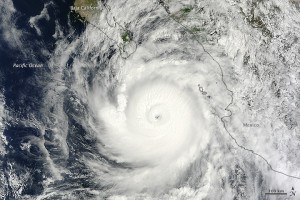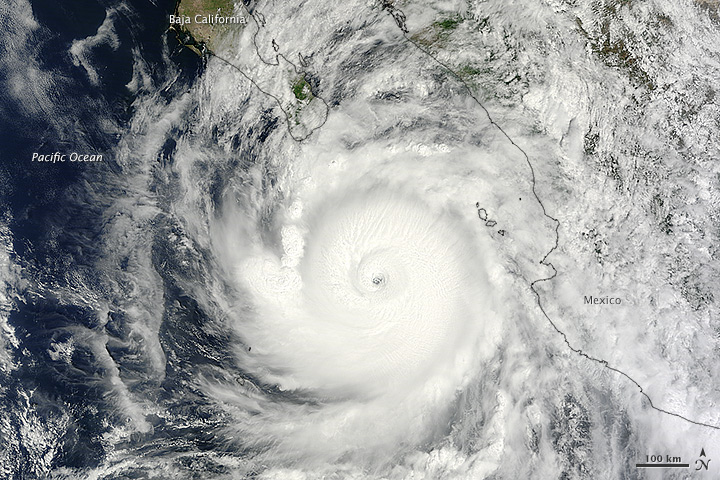Hurricane Odile, the strongest to hit Baja California Sur in decades, weakened slightly as it battered the Mexican peninsula with high winds and rain.

Odile went ashore near the resort city of Cabo San Lucas at about 10:45 p.m. Mexico City time yesterday as a Category 3 storm with winds of 125 miles (201 kilometers) per hour, tying 1967 storm Olivia as the area’s most powerful at landfall in the satellite era, said the U.S. National Hurricane Center.
It is now a Category 2 system about 65 miles east of Cabo San Lazaro, Mexico, the hurricane center said at 10 a.m. Mexico City time today. Top winds fell to 100 mph from 110 mph three hours earlier.
“Steady weakening is forecast during the next 48 hours,” the center said. “A dangerous storm surge is expected to produce significant coastal flooding in areas of onshore winds in the hurricane warning area.”
Red Alert
Mexico declared a red alert yesterday along the coastline of the Gulf of California as well as the mainland as the country prepared to celebrate its independence day holiday tonight.
Photographs posted on Twitter showed damaged beaches, overturned vans and a debris-strewn marina in the Los Cabos resort area. Odile left more than 200,000 people without power in the municipalities of Los Cabos and La Paz, according to Mexico City-based newspaper Reforma.
As of 10 p.m. yesterday in Mexico City, 18 flights, or about 30 percent, in and out of Los Cabos International Airport had been canceled, according to FlightAware, a Houston-based airline tracking company.
Mexico’s Interior Ministry declared parts of Baja California Sur state to be disaster areas today, citing heavy rains at the beginning of this month.
Hurricane conditions will spread north over the peninsula today and tomorrow, the Miami center said. Six to 12 inches (15 to 30 centimeters) of rain are forecast and storm surge may reach 6 to 10 feet (1.8 to 3 meters) high, with waves pounding in on top of that, said Steve Wistar, a meteorologist at AccuWeather Inc. in State College, Pennsylvania.
Forward Motion
Tropical systems in the Northern Hemisphere spin counter- clockwise, and when added to the forward motion of the storm, this means the northeast side is the most powerful. There is a good chance Odile will cause extensive damage, Wistar said. Hurricane-force winds reach out about 50 miles from its center, and tropical-storm strength winds extend about 185 miles.
Residents were told to leave their homes if they didn’t feel safe and know the route to a temporary shelter in case they decided to leave later, according to Mexico’s civil protection agency. Everyone was told to stay indoors.
Storms of this strength can damage buildings and block roads as trees are uprooted, according to the center. Toppled power lines can cause outages lasting for days.
Widespread heavy rain is forecast for Baja California Sur, as well as the Mexican states of Colima, Jalisco and western Michoacan to the east, the center said. Isolated regions may receive as much as 18 inches of rain.
The hurricane center calls for Odile to deteriorate into a depression, the weakest form of tropical system, by the end of the week.
The U.S. Southwest has a good chance of getting another round of flooding rain as the moisture from Odile heads north, Wistar said.
(With assistance from Brendan Case in Mexico City.)
Was this article valuable?
Here are more articles you may enjoy.


 Poll: Consumers OK with AI in P/C Insurance, but Not So Much for Claims and Underwriting
Poll: Consumers OK with AI in P/C Insurance, but Not So Much for Claims and Underwriting  Property Restoration Industry: A Culture in Need of Repair?
Property Restoration Industry: A Culture in Need of Repair?  Hawaiian Electric Hits 40-Year Low Ahead of Maui Fire Report
Hawaiian Electric Hits 40-Year Low Ahead of Maui Fire Report  Harvard Study Again Stirs the Pot on Demotech Ratings of Florida Carriers
Harvard Study Again Stirs the Pot on Demotech Ratings of Florida Carriers 